|
Canon RF 100-400mm f/5.6-8 USM IS - Review / Test Report |
|
Lens Reviews -
Canon EOS (Full Format)
|
Review by Klaus Schroiff, published November 2023

Introduction
As of the time of this review, Canon R-mount is still a closed system. If you are a professional photographer, you won't mind much because the system is very much aligned to pros.
However, things are a little more complicated if you can't tax-deduct your purchases. Third-party lenses are all but absent, and the only budget tele-zoom lens option is the Canon RF 100-400mm f/5.6-8 IS USM.
It is a comparatively slow lens, but it is quite affordable at around $ 650 USD or 600 EUR, even when comparing it to similar (albeit slightly faster) third-party options in other systems.
 The lens may have a comparatively slow max aperture. However, this also translates to very compact dimensions as well as low weight, so it won't be a burden when traveling around.
The build quality of the Canon lens is pretty decent for a consumer-grade lens. Of course, the lens barrel is made of engineered plastics based on a metal mount. It uses an extending zoom design, and is quite long at the 400mm setting. The rubberized focus and zoom control rings operate smoothly. A configurable control ring can be used to adjust a variety of exposure settings, including aperture, ISO, and exposure compensation. Unfortunately, Canon didn't bother with weather-sealing nor with providing a lens hood.
The lens may have a comparatively slow max aperture. However, this also translates to very compact dimensions as well as low weight, so it won't be a burden when traveling around.
The build quality of the Canon lens is pretty decent for a consumer-grade lens. Of course, the lens barrel is made of engineered plastics based on a metal mount. It uses an extending zoom design, and is quite long at the 400mm setting. The rubberized focus and zoom control rings operate smoothly. A configurable control ring can be used to adjust a variety of exposure settings, including aperture, ISO, and exposure compensation. Unfortunately, Canon didn't bother with weather-sealing nor with providing a lens hood.
 The lens relies on Canon's "Nano USM" for auto-focusing - it is silent and pretty snappy. Manual-focusing works "by-wire" which is no surprise anymore. The manual focus feedback is decent. The built-in Image Stabilizer (IS) helps to minimize camera shake by 5.5 stops. When working with select cameras, up to 6 stops of stabilization are possible in combination with the camera's sensor-based IS. Depending on your coffee intake, it'll usually be less than that, but it's quite effective nonetheless. Technically, the Canon RF 100-400mm f/5.6-8 USM IS is compatible with optional Extender RF 1.4x and Extender RF 2x teleconverters, although, besides a degradation of image quality, you'll end up with a really slow max aperture (x1.4 = 560mm f/11, x2 = 800mm f/16).
The lens relies on Canon's "Nano USM" for auto-focusing - it is silent and pretty snappy. Manual-focusing works "by-wire" which is no surprise anymore. The manual focus feedback is decent. The built-in Image Stabilizer (IS) helps to minimize camera shake by 5.5 stops. When working with select cameras, up to 6 stops of stabilization are possible in combination with the camera's sensor-based IS. Depending on your coffee intake, it'll usually be less than that, but it's quite effective nonetheless. Technically, the Canon RF 100-400mm f/5.6-8 USM IS is compatible with optional Extender RF 1.4x and Extender RF 2x teleconverters, although, besides a degradation of image quality, you'll end up with a really slow max aperture (x1.4 = 560mm f/11, x2 = 800mm f/16).
| Specifications |
|---|
| Optical construction | 12 elements in 9 groups (1x UD, 1x aspherical) |
| Number of aperture blades | 9 (rounded) |
| min. focus distance | 0.88m (max magnification 1:2.44) |
| Dimensions | 79.5x164.7mm |
| Weight | 635g |
| Filter size | 67mm |
| Hood | barrel-shaped, bayonet mount, optional |
| Other features | Control Ring, image stabilizer |
Distortion
The Canon RF 100-400mm f/5.6-8 USM IS produces medium pincushion distortions in RAW images. The ease somewhat towards the 400mm.
The distortions are almost perfectly corrected with activated image auto-correction, as you can see below.
Vignetting
The RAW vignetting is about average for a super tele-zoom lens. The light falloff is most visible at around 1.6EV (f-stops) at 100mm f/5.6 but remains comparatively mild at 400mm (1.1EV). Stopping down by 1 f-stop resolves this mostly already.
 The vignetting is negligible with activated image auto-correction
The vignetting is negligible with activated image auto-correction
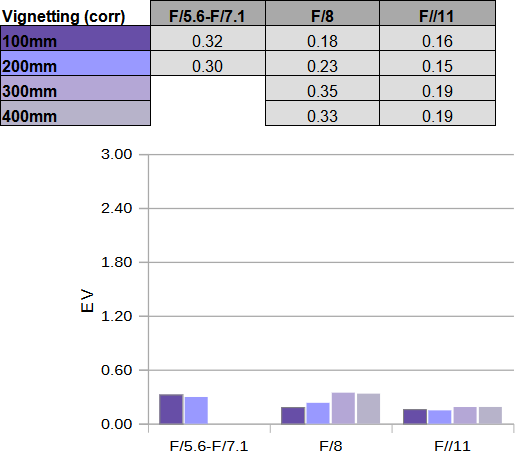
MTF (resolution)
In terms of resolution, the Canon RF 100-400mm f/5.6-8 USM IS is quite good for what it is. On the positive side, the broader center performance is very good throughout the range - and that's what's most important with such a lens. It's not all that easy in the outer image field. At 100mm f/5.6, the corners are slightly soft, but they recover to very good quality at f/8 already. The lens's sweet spot is around the 200mm mark, with quite evenly high quality across the frame. At 300m, the outer image field suffers again, although the quality remains somewhat decent. This changes at 400mm, where the borders/corners suffer a bit more.
The centering quality of the tested sample was Okay (slightly less sharp on the left side). Field curvature is not an issue.
Please note that the MTF results are not directly comparable across the different systems!
Below is a simplified summary of the formal findings. The chart shows line widths per picture height (LW/PH), which can be taken as a measure of sharpness.
If you want to know more about the MTF50 figures you may check out the corresponding Imatest Explanations

Chromatic Aberrations (CAs)
Canon has been somewhat penny-pinching with respect to the number of UD elements in the optical design - just one, to be precise. This is a little slim for the full CA correction - and the Canon RF 100-400mm f/5.6-8 USM IS shows a noticeable CA pixel width of 2px at 400mm f/8 at the borders. This isn't dramatically high, but certainly higher than usual. That being said - auto-correction will still handle this.

Bokeh
The Canon RF 100-400mm f/5.6-8 USM IS is certainly a very slow lens in terms of aperture speed. However, given its long focal length, you can still produce a shallow depth of field unless we are talking about comparatively long focus distances. So, let's check out what it can give us here.
Out-of-focus highlights show an almost "bubble-like" bokeh due to a fairly pronounced outlining for the discs. Whether you like this or not is a matter of taste to some degree. However, this places it on the "has character" side of things. The inner zone of the discs is relatively clean. Stopping down emphasizes the "bubbles". The circular shape remains mostly intact even at f/11.
 The above applies to the image center. However, almost surprisingly, the Canon lens is capable of rendering almost circular highlight discs in the image corners as well.
On the downside, the general bokeh in the focus transition zone is somewhat smeary and uneven in the critical background (shown to the left below). The foreground rendering is quite a bit smoother in comparison.
The above applies to the image center. However, almost surprisingly, the Canon lens is capable of rendering almost circular highlight discs in the image corners as well.
On the downside, the general bokeh in the focus transition zone is somewhat smeary and uneven in the critical background (shown to the left below). The foreground rendering is quite a bit smoother in comparison.

Sample Images
Click on an image to download the full-size variant.
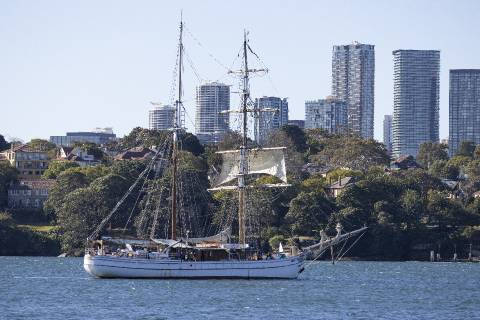 |
| Make | Canon |
| Model | Canon EOS R5 |
| ISO Speed | 320 |
| Focal Length | 225.0mm |
| Aperture: | f/7.1 |
| Exposure | 1/1000s |
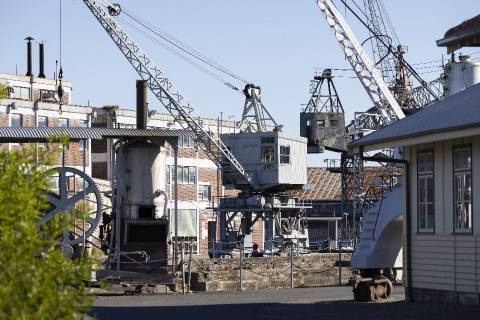 |
| Make | Canon |
| Model | Canon EOS R5 |
| ISO Speed | 320 |
| Focal Length | 156.0mm |
| Aperture: | f/6.3 |
| Exposure | 1/1000s |
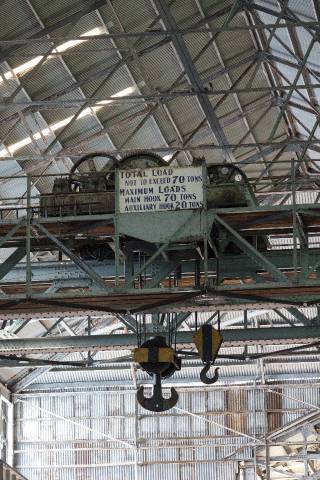 |
| Make | Canon |
| Model | Canon EOS R5 |
| ISO Speed | 1600 |
| Focal Length | 174.0mm |
| Aperture: | f/7.1 |
| Exposure | 1/30s |
 |
| Make | Canon |
| Model | Canon EOS R5 |
| ISO Speed | 1600 |
| Focal Length | 300.0mm |
| Aperture: | f/8.0 |
| Exposure | 1/2500s |
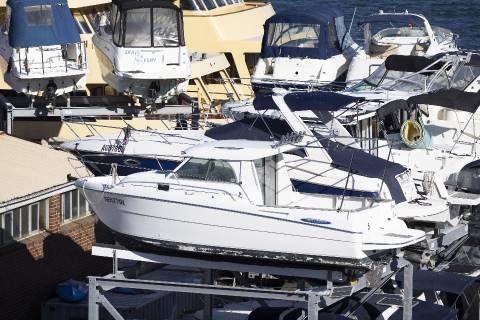 |
| Make | Canon |
| Model | Canon EOS R5 |
| ISO Speed | 200 |
| Focal Length | 200.0mm |
| Aperture: | f/7.1 |
| Exposure | 1/1600s |
 |
| Make | Canon |
| Model | Canon EOS R5 |
| ISO Speed | 200 |
| Focal Length | 135.0mm |
| Aperture: | f/8.0 |
| Exposure | 1/800s |
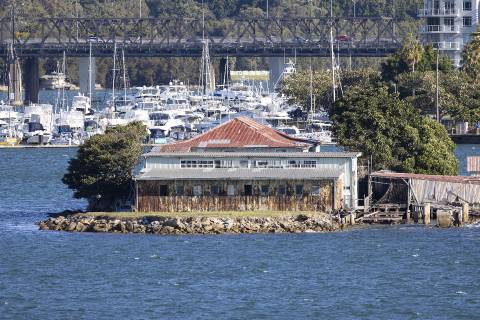 |
| Make | Canon |
| Model | Canon EOS R5 |
| ISO Speed | 200 |
| Focal Length | 400.0mm |
| Aperture: | f/8.0 |
| Exposure | 1/400s |
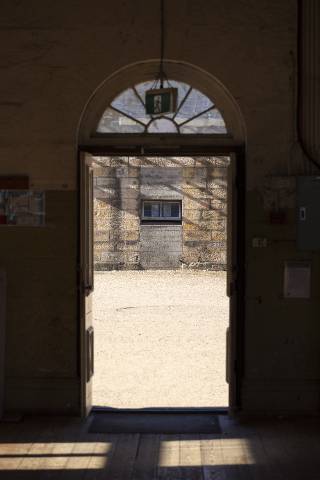 |
| Make | Canon |
| Model | Canon EOS R5 |
| ISO Speed | 200 |
| Focal Length | 100.0mm |
| Aperture: | f/5.6 |
| Exposure | 1/400s |
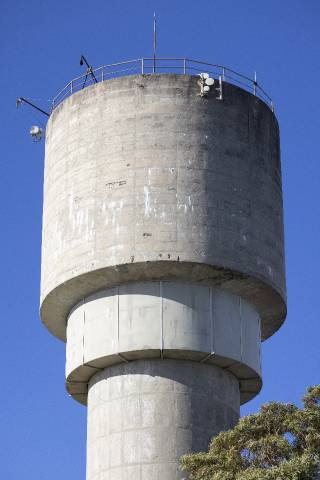 |
| Make | Canon |
| Model | Canon EOS R5 |
| ISO Speed | 200 |
| Focal Length | 100.0mm |
| Aperture: | f/8.0 |
| Exposure | 1/800s |
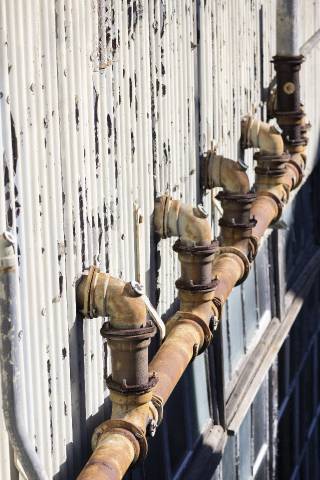 |
| Make | Canon |
| Model | Canon EOS R5 |
| ISO Speed | 200 |
| Focal Length | 123.0mm |
| Aperture: | f/6.3 |
| Exposure | 1/1000s |
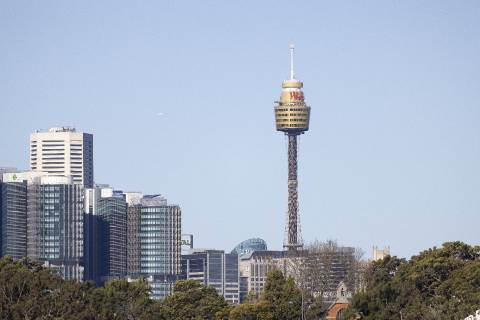 |
| Make | Canon |
| Model | Canon EOS R5 |
| ISO Speed | 200 |
| Focal Length | 400.0mm |
| Aperture: | f/8.0 |
| Exposure | 1/1250s |
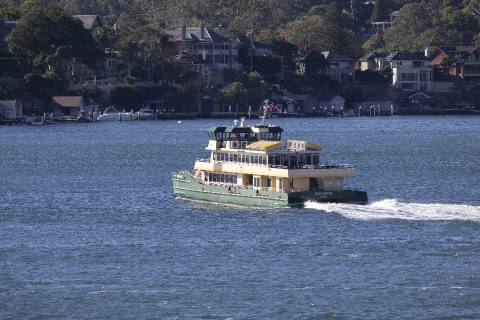 |
| Make | Canon |
| Model | Canon EOS R5 |
| ISO Speed | 200 |
| Focal Length | 400.0mm |
| Aperture: | f/8.0 |
| Exposure | 1/500s |
 |
| Make | Canon |
| Model | Canon EOS R5 |
| ISO Speed | 200 |
| Focal Length | 174.0mm |
| Aperture: | f/7.1 |
| Exposure | 1/80s |
 |
| Make | Canon |
| Model | Canon EOS R5 |
| ISO Speed | 800 |
| Focal Length | 174.0mm |
| Aperture: | f/7.1 |
| Exposure | 1/1000s |
 |
| Make | Canon |
| Model | Canon EOS R5 |
| ISO Speed | 800 |
| Focal Length | 325.0mm |
| Aperture: | f/8.0 |
| Exposure | 1/3200s |
 |
| Make | Canon |
| Model | Canon EOS R5 |
| ISO Speed | 800 |
| Focal Length | 325.0mm |
| Aperture: | f/8.0 |
| Exposure | 1/3200s |
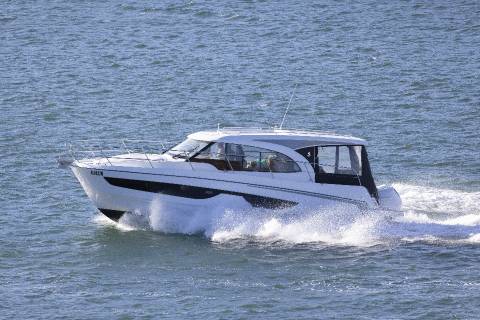 |
| Make | Canon |
| Model | Canon EOS R5 |
| ISO Speed | 800 |
| Focal Length | 400.0mm |
| Aperture: | f/8.0 |
| Exposure | 1/1600s |
Verdict
Yes, the Canon RF 100-400mm f/5.6-8 IS USM may not be the most fancy lens around, but it has to balance price and quality. Unlike lenses with shorter focal lengths, the center of attention is usually near the image center, and the Canon lens is capable of delivering pretty sharp results here. The outer image field is less impressive at the long end of the range. The sweet spot in terms of sharpness is around the 200mm mark, with a quite even performance here. Lateral CAs are good at 100mm but increase quite a bit the more you zoom out. However, image auto-correction will help here, as well as with the pincushion distortion that is present from the mid-range up. The raw vignetting is reasonably well-controlled and mostly gone with auto-correction. A weakness is the bokeh. To start with, the depth-of-field is usually quite broad, limiting the blur in the out-of-focus area substantially. The bokeh rendering is also somewhat harsh, and the "bubble-like" highlights may not be everybody's darling on such a mainstream lens.
The build quality is decent relative to the price of the lens. The plastic quality feels quite good, and at least our sample didn't exhibit any wobbling. The target audience will surely also appreciate the compact size and low weight. A drawback of a lens that is often going to be used outdoors is the lack of weather-sealing. And while we are at cost-savings - Canon should abandon its practice of not providing a lens hood with its consumer-grade lenses. A plastic hood is a penny item for them, really, and asking an additional $25 is a bit ridiculous. The AF is both snappy as well as silent. The image stabilizer works effectively, although you shouldn't rely on the 5-6 f-stop gain that Canon is promising.
Overall, the Canon RF 100-400mm f/5.6-8 IS USM is a good lens for the money, especially for those with a lower-megapixel camera body. If you want more ... well ... the RF 100-500mm f/4.5-7.1 USM L IS will cost you 5x this much.
Mechanical Quality:
★★★★★
What does this mean ?
|
|